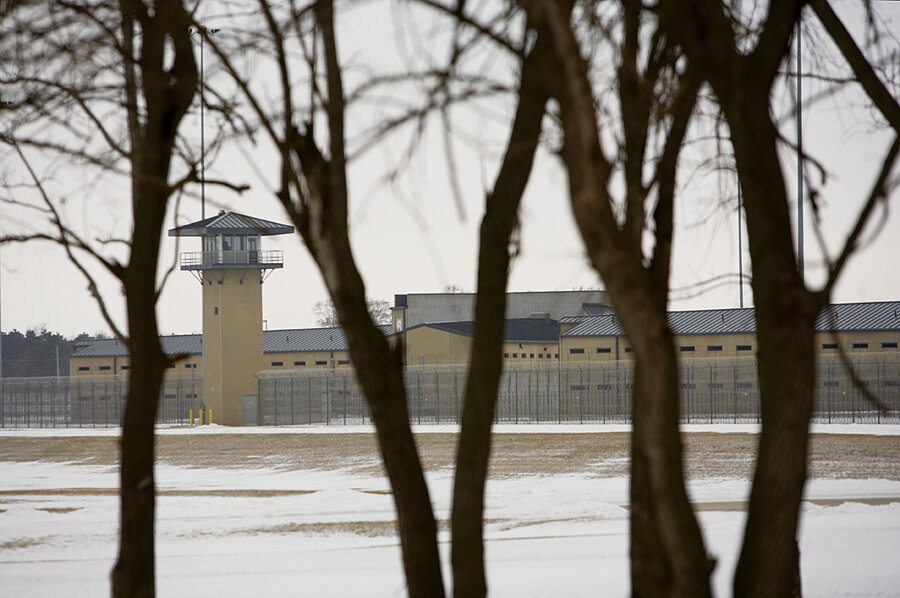Can a terror prison spark a boom?
Loading...
| Chicago
It’s a familiar story: Faced with shuttered businesses, dying downtowns, and consolidated schools, rural communities across America grab the chance to host a new enterprise, maybe a meatpacking factory or a landfill. In Thomson, Ill., it’s a local prison revamped to house terror suspects from Guantánamo Bay and other federal prisoners.
Hopes are high that the proposed facility will turn Thomson’s fortunes around. “We need to be safe, we need to give people hope, we need to give people opportunities to keep their families here,” says Jerry “Duke” Hebeler, village president. “This is our shot to do all three.”
The Obama administration is equally upbeat. Under federal management, the Thomson prison would create as many as 2,960 jobs and “local residents will be excellent candidates” for half of them, says a report by the president’s Council of Economic Advisers (CEA). It predicts that the county unemployment rate, 12.1 percent in December, could fall by as much as four percentage points.
But such predictions are almost always overstated, the hoped-for benefits mostly illusory, say researchers who have studied the economics of rural prisons. Studies over the past decade conclude that prisons have done little to change the economic realities of rural communities.
“Most of the communities that I’ve talked to have been somewhat disappointed after they see what happens,” says Thomas Johnson, an agricultural economist at the University of Missouri in Columbia. “They don’t think it’s a mistake. But they don’t find the economic benefits that were suggested.”
In some circumstances, research suggests, prisons have actually done harm.
“The towns that get prisons, especially the most desperate communities, tend to be worse off,” says Gregory Hooks, a sociology professor at Washington State University and author of two studies of rural prisons. “That was a surprise.”
Mr. Hooks and other researchers have used census data to compare rural counties with and without prisons. These studies show that prisons fail to increase total employment, raise incomes, or reduce poverty. It’s not clear why. One reason may be that local people get relatively few prison jobs because they lack the skills and qualifications needed to work as guards or administrative staff. Researchers also speculate that prisons may displace other economic activity.
Moreover, unlike factories and other economic development, prisons generate little extra business. They are centralized institutions with their own distant suppliers. “Prisons have had nowhere the positive economic benefits people say they will have,” says Boyce Sherwin, a former director of community development in Malone, N.Y., a town with three prisons.
Before the 1980s, most prisons were built in urban areas. But the 1980s and ’90s saw a prison boom in rural areas, in part because stricter sentencing guidelines spawned a growing population of prisoners. Rural towns welcomed and even competed for prisons. Some struggling areas, like Michigan’s Upper Peninsula, have become centers of the prison industry.
No surge in Rush City
When Minnesota opened a prison in Rush City in 2000, some officials predicted big economic benefits. But it generated fewer jobs for residents and less economic boost than many hoped. “I guess I’ve not seen where it’s made any difference in our city,” says Mayor Nancy Schroeder.
In recent years, the opening of new prisons has ebbed. Budget woes have forced some states to close prisons. But new prisons are still under construction, such as a federal prison in Berlin, N.H.
The White House says studies “confirm the essential point that prison openings tend to raise employment and prosperity in the local community.” Researchers object that their studies confirm no such thing. “There’s nothing in the literature I’ve seen to justify the optimistic predictions the CEA makes,” says Hooks. (Neither the White House nor the CEA responded to requests for comment.)
Decision may await federal budget
Illinois aims to sell the Thomson prison, built in 2001 and virtually empty. The White House’s fiscal 2011 budget plan includes $237 million to buy and renovate the prison. But Republicans oppose moving Guantánamo prisoners to the mainland and may try to block the purchase. President Obama has said he can’t close the facility as soon as he had promised.
Experts on rural development say that prisons are just one example of a number of controversial enterprises, including landfills and power stations, that end up in desperate rural communities. These communities have alternatives, they say.
“The strategies that work build on assets in the community rather than pulling in something it doesn’t have,” says Deborah Tootle, community development professor at the University of Arkansas and president-elect of the National Association of Community Development Extension Professionals. A prison “is going to bring in a few jobs. [But] is it going to benefit the community over time? It’s really a question of scale and time.”





